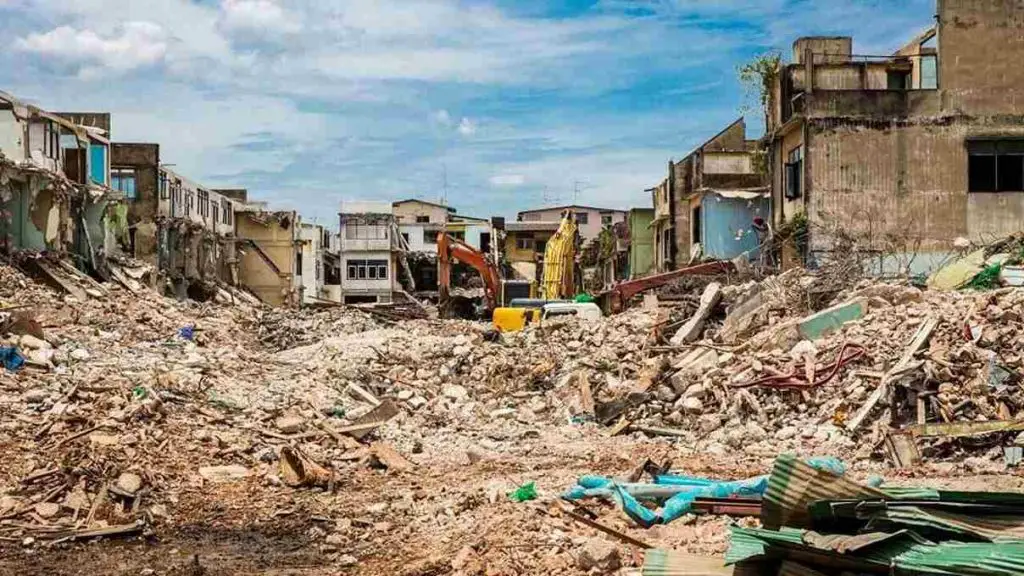When we think of earthquakes, we usually think of the ground shaking due to the friction between tectonic plates. However, there is another type of earthquake known as a triggered earthquake. These are smaller earthquakes that occur after a larger one in the same area. A triggered earthquake is an earthquake that occurs as a result of another earthquake.
More specifically, it also refers to any seismic event where stress on pre-existing faults is increased significantly and results in smaller but more numerous aftershocks than normal for that location. A triggered quake can be any magnitude, but it can only happen near active fault lines. This article will explain what triggered earthquakes are, how they occur, and examples of triggered quakes from history. Keep reading to learn more!

What is a Triggered Earthquake and How Does it Occur?
Earthquakes are usually caused by the tectonic plates in the Earth’s crust (the upper, rigid layer of the planet) moving past each other. This results in a slip along the interface between the plates, releasing energy that travels through the Earth as seismic waves. Triggered quakes, however, occur when a seismic event (i.e. an earthquake) increases the stress on pre-existing faults in the rock and causes them to move.
One example of this is when a large earthquake causes the pressure in an adjacent fault to drop, making it easier for the fault to move. Another way this can happen is when a large earthquake shifts the ground in such a way that it moves an existing fault, allowing it to move more easily.
Types of Triggered Earthquakes
Triggered earthquakes are any seismic event that occurs after a larger earthquake in the same area. This larger quake can be an aftershock, a tsunami, or even a foreshock. A triggered earthquake is also known as a “syndicated earthquake.” An aftershock is a smaller earthquake that follows a larger one, often in the same region.
A foreshock is a smaller earthquake that precedes a larger quake. A triggered earthquake is not the same thing as a “foreshock”. A syndicated earthquake is when a larger earthquake triggers another one in a different region. A triggered earthquake can be any magnitude, but it can only occur near active faults.
What is an Aftershock?
Aftershocks can occur after any large earthquake, and they are smaller earthquakes that occur in the same general area as the original event. Aftershocks can last for days, weeks, or even years after a major earthquake, with some of the most intense aftershocks occurring in the first few days after the quake.
Aftershocks are caused by the sudden movement of geological faults, which allows rocks to move past each other more easily. After the initial earthquake, the geological faults are left in a state of increased stress that makes it easier to make them move again. Aftershocks can be stronger than the initial earthquake, but they are also less likely to occur. They are usually smaller quakes and are less damaging than the initial event.
Existing Faults Triggering Quakes
Much like an earthquake can trigger a smaller earthquake, the larger earthquake can be caused by the smaller one. When the smaller earthquake happens, it will cause the bedrock it’s in contact with to suddenly drop down. This sudden drop in the bedrock can cause a larger earthquake that happened after the smaller one.
Existing faults in the rock can also cause larger earthquakes after smaller ones in the same way. When a smaller earthquake happens, it can cause stress to build up on the already existing faults. Eventually, the stress will be so high that the faults will move, causing a larger earthquake.
Examples of Triggered Earthquakes
The 1906 San Francisco earthquake was the result of an aftershock triggering a larger earthquake in the same fault line. The original earthquake measured 7.8 on the Richter scale and resulted in more than 3,000 deaths. The aftershock that triggered the larger earthquake measured only a 6.0 on the Richter scale, but it caused even more damage than the original due to the different locations of the epicenter.
Many scientists also believe that the 9.0 earthquake that hit Japan in 2011 caused a triggered earthquake in New Zealand. It’s believed that the earthquake that struck Japan triggered a fault line near New Zealand, causing a smaller earthquake that measured 6.0 on the Richter scale.
How Can We Prepare For Triggered Quakes?
While triggered earthquakes are not predictable, scientists are trying to find ways to prepare for them. Geologists are currently working to find more about faults in the Earth’s crust that could cause triggered earthquakes. The more we understand about these faults, the more likely we can predict when they will cause an earthquake, whether it be a triggered one or not.
Conclusion
Triggered earthquakes are smaller earthquakes that occur after a larger earthquake in the same area. This larger quake can be an aftershock, a tsunami, or even a foreshock. Scientists are working to understand more about faults in the Earth’s crust that could cause triggered earthquakes.
Keep reading to learn more about triggered earthquakes and how they occur. You can also learn how to prepare for triggered earthquakes by learning more about faults in the Earth’s crust.
Additional Contents:

